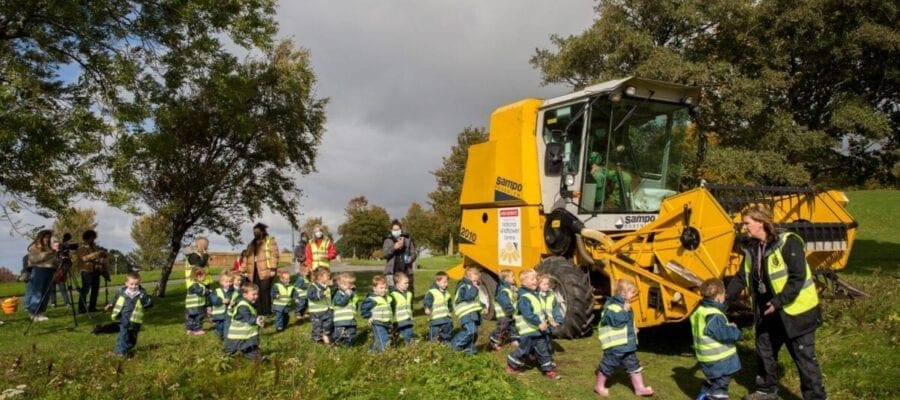The National Wildflower Centre is deepening its roots in Liverpool, teaming up with young environmentalists to transform green spaces into vibrant meadows across the city
After the centre’s HQ in Knowsley, five miles from Liverpool city centre, closed in January 2017, the Cornwall-based Eden Project stepped in to protect its legacy and continue its vital work restoring wild habitats, species, landscapes and biodiversity around the UK.
National Wildflower Centre Director Richard Scott led the way again when he brought back a combine harvester to Everton Park in the centre of the city, supported by teams of primary school pupils.
The latest mission was to harvest millions of viper’s bugloss seeds so that swathes of the blue flower can be among the wide range of colourful wildflowers sown around Liverpool and other parts of the UK.
Among the pupils joining Richard for the harvest was a group from All Saints Catholic Primary School in Anfield, Liverpool.
An All Saints team of Eco Emeralds featured to great acclaim in the recent ITV documentary Prince William: A Planet For Us All. The film showed how they have transformed part of Thirlmere Park, the nearest big green space to the school, by planting a mix of wildflowers.
The TV cameras came back again, this time a crew from Granada TV, capturing the action as a group of All Saints pupils and another from The Beacon Church of England Primary School, Everton, joined Richard for the seed harvesting in Everton Park.
They were joined by singer-songwriter Ian Prowse with an adapted song for the day, Flowers to the People, and legendary Liverpool football Club banner maker Peter Carney, with a celebration banner made especially for the occasion.
Thirlmere Park and Everton Park are two of 16 sites covering over 15 hectares across the city that have been planted with wildflowers by the National Wildflower Centre over the last two years with the help of more than 700 schoolchildren and a variety of community groups.
Richard Scott said: “With great support from Liverpool City Council, and as part of their solid response to the climate emergency and extinction crisis, we continued to work through the lockdown period to deliver head-turning wildflower displays in the north, south, east and west of the city.
“We have grown wildflowers in playful, prominent and unexpected places. It has been a privilege to bring some joy amid the sadness and uncertainty we have lived through this year due to the pandemic. It is great how this has brought new value to nature to many who have enjoyed the flowers.”
He said the dedicated work of the schoolchildren and community groups demonstrated a real “scouseflowerhouse” philosophy – now a term of endearment in the city.
Richard added: “The schools have been extraordinary. The children have become sustainable development champions for Liverpool, one of the few cities in the world voluntarily reporting on sustainable development goals.
“It proves we can reverse biodiversity decline. The kind of cornfield annual and arable weed habitats witnessed here are among the rarest habitats in the European countryside, but are easy to grow and great conservation openers for change.
“From this point we can start to add more species and diversity in a real journey of positive change, which many others can join.
“Most importantly, the landscapes we are creating are setting standards in demonstrating local authority response to both the climate emergency and extinction crisis.”
In Cornwall, the wildflower centre has established a seed bank at the Eden Project and created wildflower meadows on the outer estate beyond the world-famous Biomes.
The centre has been supporting St Austell Bay Economic Forum and Cornwall Council’s “Making Space for Nature” programme in the creation of a wildflower corridor along the A391, and hope to expend this display to the new St Austell-A30 Link Road once completed.
The National Wildflower Centre has been instrumental in bringing two World Society for Ecological Restoration (SER) conferences to the UK (2000 and 2015), and linking with global community of ecological restoration professionals.
Most recently the centre’s work was selected to be included in a best practice for “nature based solutions” at UN-Habitat’s World Urban Forum in February 2020, which is in important in shaping the UN’s declared decade of ecological restoration worldwide.

